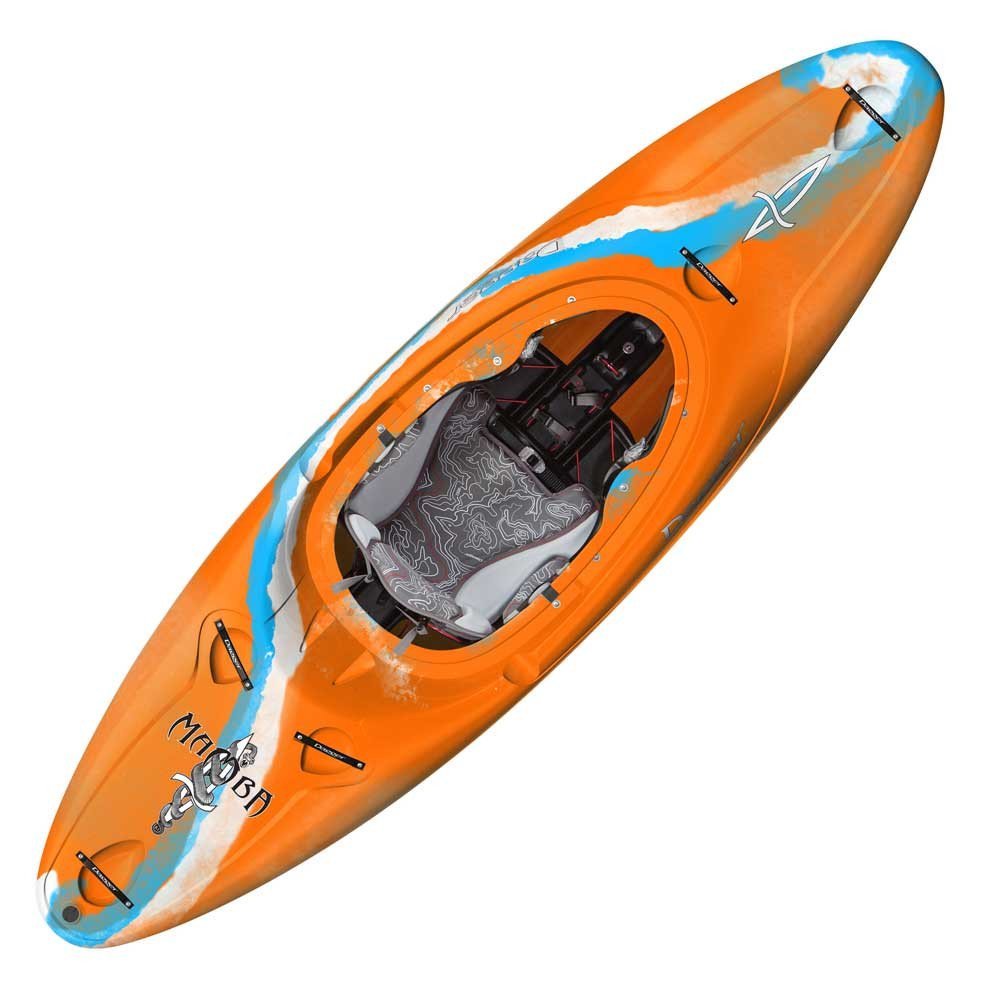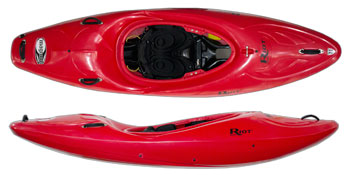
Getting started whitewater kayaking is a serious endeavour. I highly recommend that you begin with a lesson from a qualified instructor before setting out on your own. This will give you the necessary skills and knowledge to stay safe on the water. It’ll also give you an opportunity to test out different types of whitewater kayaks before you drop a bunch of dough on a new boat!
Once you’ve had a lesson or two and know the basics of paddling and water safety, you might be ready to buy your own whitewater kayak. But be warned, there’s a lot more to know about the purchase of a whitewater kayak than you might think. To help you make the best choice, we’re going to explain the ins and outs of these specialist boats and then review a few popular models you might choose from. Sit back and relax while we walk you through it!
And Our Pick of the Best Whitewater Kayaks Are…
Product | Weight | Capacity | Dimensions | Price | Our Rating |
|---|---|---|---|---|---|
44 lbs | 170 lbs | 7'7" x 25.5" x 14" | $$$ | ||
38 lbs | 230 lbs | 6'4" x 26" x 18" | $$ | ||
45 lbs | 180 lbs | 8'4" x 26.5" x 16" | $$ | ||
37 lbs | 220 lbs | 9'1" x 28' x 14" | $ | ||
50 lbs | 210 lbs | 9'7" x 26" x 14" | $$$ |
Scroll down to see full reviews!
Types of Whitewater Kayaks
You may or may not know that not all whitewater kayaks serve the same purpose. Within this niche, there are several different sub-niches of boats.
Freestyle Boats
These boats usually run less than 7 feet in length. They have planning hulls for great surfing and aerial tricks in holes and currents. They’re squirrely and poor down-river boats that favor sport over speed. These boats are usually not meant for seriously challenging whitewater.
River Running Playboats
These boats are halfway between a river runner (up next) and a freestyle boat. They usually measure 6.5–8 feet in length. They’re made for downriver performance and freestyle paddling but hold the requisite length needed to be comfortable down-river paddlers. Competent paddlers may use this boat type for running rapids. Unlike freestyle boats, river running playboats are usually symmetrical on the bow and stern.
River Runners
Measuring in between 7.5–9 feet in length, river runners are meant to paddle downstream. These boats may be a little flatter, featuring less rocker, than shorter boats. This allows them better speed and control on the straights. These are good learning boats for easy to moderate whitewater, though skilled paddlers can be effective in all water types on these boats.
Creek Boats
These boats usually start at 7.5 feet and run up to 9 feet in length. They’re large volume vessels meant to take on speed and difficult water. Your river running boat should have large rocker to make boofing easy and help you skim through large waves. Chines on these boats can be soft or hard, depending on your needs. Choose a soft chine boat for shallow, rocky areas or jumping and boofing. Choose a hard chine boat for finesse and maneuverability.
Long Boats
At more than 9 feet in length, these boats can be quite slender and voluminous. These boats, when chosen correctly, can be great expedition boats for moderate whitewater where the extra size means space for storing gear. Unfortunately, the relatively long boat hull means that you’ll be forced to sacrifice maneuverability for stability. More so than other boats, long boats deserve careful attention to your choice of rocker. Be sure to ask an expert for help if you’re unsure.
How to Choose the Best Whitewater Kayak for Beginners
For newbies especially, understanding the differences in whitewater kayaks is critical to making an informed purchasing decision. Being happy with your buy comes from firstly knowing exactly the type of whitewater boat you want. Once you’ve decided on exactly how you’re going to be playing in the rapids, you can then take a closer look at the hull shape and design.
The shape and dimensions of the kayak, more than anything, is what determines its suitability as a whitewater vessel. So, with that in mind, let’s look at shape characteristics for these type of boats.
Chines
Chines are the part of the boat’s hull which sit below the waterline. Sometimes these are hard, rigidly defined contours in the boat’s design. Sometimes they’re soft or more contoured.
Hard chines provide more control and agility but present several drawbacks. Hard chines can get caught on rocks or obstacles and cause the paddler to lose control. Hard chines also catch currents and changes in water flow more abruptly than softer chines, which can make the boat feel erratic.
Boats with soft chines are more gentle and forgiving to both paddler and water. Their drawback, however, is that they require much more steering and control input from paddle strokes and can’t be easily controlled by tipping and angling the boat for swift maneuvers.
Rocker
Just like in skiing, rocker refers to the amount of upward curve in your whitewater boat. In general, the more rocker, the more maneuverable your boat will be. The flatter your boat is (less rocker), the better it will be at tracking straight and handling speed.
Boats with greater degrees of rocker tend to ride over waves and obstacles more readily than those with straighter designs. Rocker also allows a boat to recover from off-kilter landings more easily. There are yet other considerations to rocker that you might make if you’re considering some serious jumping or boofing.
Hull Design
The hull is the exterior shell or body of your new boat. Hull design refers to the overall profile or shape of the boat. In general, there are two major deviations of style when it comes to whitewater hulls.
Planing Hull refers to boats with flat bottom surfaces. Their design lends itself well to agility and performance due to the boat’s tendency to “plane” across the face of the water. They may be slightly slower than other hull models on flat water, but they’ll make up for the difference with a boon of agility in rough conditions.
Displacement Hull refers to boat designs with a rounded bottom. These boats tend to draft lower in the water and “cut in” to the water more deeply. Because these boats cut more deeply beneath the surface of the water, they tend to paddle straighter and forgive minor input errors more readily.
Whitewater Kayak Reviews
Product | Weight | Capacity | Dimensions | Price | Our Rating |
|---|---|---|---|---|---|
44 lbs | 170 lbs | 7'7" x 25.5" x 14" | $$$ | ||
38 lbs | 230 lbs | 6'4" x 26" x 18" | $$ | ||
45 lbs | 180 lbs | 8'4" x 26.5" x 16" | $$ | ||
37 lbs | 220 lbs | 9'1" x 28' x 14" | $ | ||
50 lbs | 210 lbs | 9'7" x 26" x 14" | $$$ |
Scroll down to see full reviews!
Dagger Mamba Creeker 7.6 Kayak

This agile little boat is meant to tackle narrow waters with steep pitches and serious speed. We recommend this boat for aspiring creekers who want something they can grow with.
The planing hull increases agility and makes even the hardest whitewater a matter of simple finesse. High volume bow means tons of pop for skimming those holes. You’ll be bobbing along the surface of the water like a high-octane piece of awesome fishing tackle! Dagger went out of their way to stiffen this boat up with an improved seat, added rigid storage tray, and a hard-plastic design with tons of reinforcement.
This beauty is for everyone from beginner to expert, and you’ll love paddling in this boat no matter how advanced your skills. We recommend this boat as the best overall balance of performance, growth, and design for the beginner whitewater paddler with aspirations to really crush those rapids!
Riot Kayaks Astro 58 Whitewater Playboating Kayak

If you’re looking to get started with some freestyle paddling on gentle whitewater and learning to do some pretty neat tricks is your primary goal, then this boat might be for you!
At only 6.3 feet in length, it’s definitely a freestyle boat with little down-river control. Under the water, it’s sporting a planing hull designed for maximum maneuverability and hard chines. This boat isn’t meant to tackle difficult whitewater, but you’ll certainly have fun at the local park-and-paddle getting tricky with your mates.
This is a great boat for beginner freestyle whitewater paddlers, but we advise you to look for something with more length if you’re hoping to paddle aggressive down-river currents and big rapids.
Riot Kayaks Magnum 80 Whitewater Creeking Kayak

At just over 8 feet long, this creeking boat features heavy rocker on both the bow and stern. These features make the displacement hull a balanced choice for stability and control.
Soft chines on the side of the boat mean you’ll have more forgiveness, but you’ll be forced to paddle the boat more sternly to get inputs to be effective. With a lightweight 45 pounds, you’ll be able to easily carry this boat to and from the river with ease. If you ever need to portage, you’ll be glad that your boat is light because it gets tiring quickly carrying a boat over boulders.
This is a more mid-range choice for beginner whitewater kayakers as the added length, and displacement hull creates more stability and down-river capability than the shorter Astro 58. You’ll be able to paddle this playful boat in a variety of whitewater while still having the features you need to enjoy your time on the water.
Dagger Kayaks Zydeco 9.0

This 9-foot-long kayak from Dagger is meant for the beginner looking to handle everything from flatwater to fast moving inlets. You’ll be able to get started exploring whitewater and harder water with confidence in their beginner-friendly boat.
With knee pads, foot braces, and padding on the sides of the cockpit, they’ve designed this one for comfort and all-day ergonomics. Contoured foam seats with multiple adjustment positions are the perfect option for getting the perfect level of fitment from your boat. They’ve even kept the weight under 40lbs total, so it’s easy to get this boat on to car-top carriers by yourself.
Overall weight capacity is 220 pounds with a cockpit measuring just under 22” wide. You’ll want to keep this kayak on the more gentle waters, but it’s an excellent choice for beginners looking to “get their feet wet”. As your skill level progresses into more advanced water, you’ll want to consider a boat that is specific to the type of whitewater paddling you love to do!
Dagger Kayaks Katana 9.7

This kayak is meant to head straight into any water situation you can throw at it. From whitewater to flat water, the Katana Kayak is built to bridge the gap of technical capability with forgiving features for any situation.
At nearly 10 feet long, this kayak won’t be the most agile boat in the water. The tradeoff, however, is that you’ll be able to enjoy long weekend paddles on flat water with friends just as well as a burst through some Class III. Round stern and removable bulkhead mean you can shed water from diving through rapids and adjust the boat to fit as much gear as you need.
If you’re planning to spend more time on lazy weekend flat water trips than in the whitewater, we recommend this boat. If you’re serious about whitewater and expect to progress rapidly, this might not be the boat for you. There’s a good chance the serious paddler will find this boat “boring” in the whitewater after a season of practice. It's available in three colors: orange, lime green and pink!
Conclusion
Whether you’re planning to spend most of your time on lazy rivers with the occasional shot of whitewater, or if you’re hoping to become a serious competitor in creeking, we’ve got something on our list for you. Remember to consult our section on how to choose the best whitewater kayak before just picking any old boat. It’s important to understand how kayaks are built and which one is the best overall choice for your needs!
As an Amazon Associate, we earn from qualifying purchases. This is without any additional costs for the buyer but does support us in maintaining our website.




The Riot is by far my favorite. It has great stability and moves around well. Highly recommended.